Climate Change and Agricultural Risks: Perception of Farmers from a Socio-Economic Sustainability Perspective
Abstract
Abstract
1. Introduction
Research Contribution
- How do Libyan farmers perceive climate change and its potential impact on their agricultural activities?
- What are the perceived risks associated with climate change among Libyan farmers?
- What socio-economic factors significantly influence farmers’ climate risk perceptions and adaptation behaviors?
- To what extent do socio-economic characteristics determine the level and type of climate change adaptation strategies adopted by Libyan farmers?
2. Research Design
2.1. Study Area and Population
2.2. Sampling Technique and Size
2.3. Data Collection Tool
- Climate change awareness: This is characterized as a farmer’s awareness of the causes and impacts of climate change [35]. Climate change awareness is a reported factor in influencing the perceived risks and associated vulnerabilities of farmers towards climate change [36]. A twelve-item scale was adapted from the study by Sen et al. [37].
- Climate change risk perception: This is characterized as the perceived susceptibility of farmers to climate change effects such as droughts and floods [38]. The risk perception of climate change influences the adaptation and maladaptation of farmers towards climate change [39]. A ten-item scale was adapted from the study by Ghanaian et al. [34].
2.4. Data Analysis
3. Results
4. Discussion
5. Conclusions
5.1. Recommendations and Future Work
- Localized environmental and sustainable agricultural programs that address context-specific climate challenges faced by Libyan farmers should be developed and implemented.
- Farming cooperatives should be strengthened and empowered as key drivers of environmental education and information dissemination to farmers. Cooperatives should be equipped with the information and skills required based on current climate change trends.
- Environmental education should be integrated into agricultural extension services in rural training initiatives. This should include practical agricultural workshops demonstrating the strategies and skills required for adequate adaptation.
5.2. Limitations of the Study
Author Contributions
Funding
Institutional Review Board Statement
Informed Consent Statement
Data Availability Statement
Conflicts of Interest
References
- Datta, P.; Behera, B. Climate change and Indian agriculture: A systematic review of farmers’ perception, adaptation, and transformation. Environ. Chall. 2022, 8, 100543. [Google Scholar] [CrossRef]
- Addis, Y.; Abirdew, S. Smallholder farmers’ perception of climate change and adaptation strategy choices in Central Ethiopia. Int. J. Clim. Change Strateg. Manag. 2021, 13, 463–482. [Google Scholar] [CrossRef]
- Allan, R.P.; Arias, P.A.; Berger, S.; Canadell, J.G.; Cassou, C.; Chen, D.; Zickfeld, K. Intergovernmental panel on climate change (IPCC). Summary for policymakers. In Climate Change 2021: The Physical Science Basis. Contribution of Working Group I to the Sixth Assessment Report of the Intergovernmental Panel on Climate Change; Cambridge University Press: Cambridge, UK, 2023; pp. 3–32. [Google Scholar]
- Kogan, F. The IPCC reports on global warming and land changes. In Remote Sensing Land Surface Changes: The 1981–2020 Intensive Global Warming; Springer International Publishing: Cham, Switzerland, 2023; pp. 67–79. [Google Scholar]
- Shrestha, R.; Rakhal, B.; Adhikari, T.R.; Ghimire, G.R.; Talchabhadel, R.; Tamang, D.; Kc, R.; Sharma, S. Farmers’ perception of climate change and its impacts on agriculture. Hydrology 2022, 9, 212. [Google Scholar] [CrossRef]
- Abazinab, H.; Duguma, B.; Muleta, E. Livestock farmers’ perception of climate change and adaptation strategies in the Gera district, Jimma zone, Oromia Regional state, southwest Ethiopia. Heliyon 2022, 8, e12200. [Google Scholar] [CrossRef]
- Foguesatto, C.R.; Machado, J.A.D. What shapes farmers’ perception of climate change? A case study of southern Brazil. Environ. Dev. Sustain. 2021, 23, 1525–1538. [Google Scholar] [CrossRef]
- Zeleke, T.; Beyene, F.; Deressa, T.; Yousuf, J.; Kebede, T. Smallholder farmers’ perception of climate change and choice of adaptation strategies in East Hararghe Zone, Eastern Ethiopia. Int. J. Clim. Change Strateg. Manag. 2022, 15, 515–536. [Google Scholar] [CrossRef]
- Lee, C.C.; Zeng, M.; Luo, K. How does climate change affect food security? Evidence from China. Environ. Impact Assess. Rev. 2024, 104, 107324. [Google Scholar] [CrossRef]
- Toromade, A.S.; Soyombo, D.A.; Kupa, E.; Ijomah, T.I. Reviewing the impact of climate change on global food security: Challenges and solutions. Int. J. Appl. Res. Soc. Sci. 2024, 6, 1403–1416. [Google Scholar] [CrossRef]
- Xu, Q.; Liang, H.; Wei, Z.; Zhang, Y.; Lu, X.; Li, F.; Wei, N.; Zhang, S.; Yuan, H.; Liu, S.; et al. Assessing climate change impacts on crop yields and exploring adaptation strategies in Northeast China. Earth’s Future 2024, 12, e2023EF004063. [Google Scholar] [CrossRef]
- Chimi, P.M.; Mala, W.A.; Tchonang Djoumbi, B.L.; Fobane, J.L.; Fankam Kenmoe, F.U.; Ngamsou Abdel, K.; Yonga, G.; Dikoume, A.M.N.; Bell, J.M. Indigenous agroecological knowledge and practices for climate change adaptation in the forest-savanna transition zone at Batchenga in the Centre Region of Cameroon. Discov. Environ. 2025, 3, 16. [Google Scholar] [CrossRef]
- Lilavanichakul, A.; Pathak, T.B. Thai farmers’ perceptions on climate change: Evidence on durian farms in Surat Thani province. Clim. Serv. 2024, 34, 100475. [Google Scholar] [CrossRef]
- Ricart, S.; Castelletti, A.; Gandolfi, C. On farmers’ perceptions of climate change and its nexus with climate data and adaptive capacity. A comprehensive review. Environ. Res. Lett. 2022, 17, 083002. [Google Scholar] [CrossRef]
- Tran, T.T.; Chen, H. Climate change risk perception and adaptive behavior of coffee farmers: The mediating role of climate-related attitudinal factors and moderating role of self-efficacy. J. Environ. Stud. Sci. 2022, 12, 354–368. [Google Scholar] [CrossRef]
- Sheikh, Z.A.; Ashraf, S.; Weesakul, S.; Ali, M.; Hanh, N.C. Impact of climate change on farmers and adaptation strategies in Rangsit, Thailand. Environ. Chall. 2024, 15, 100902. [Google Scholar] [CrossRef]
- Gemtou, M.; Kakkavou, K.; Anastasiou, E.; Fountas, S.; Pedersen, S.M.; Isakhanyan, G.; Erekalo, K.T.; Pazos-Vidal, S. Farmers’ transition to climate-smart agriculture: A systematic review of the decision-making factors affecting adoption. Sustainability 2024, 16, 2828. [Google Scholar] [CrossRef]
- Zhu, X.; Wang, G. Impact of agricultural cooperatives on farmers’ collective action: A study based on the socio-ecological system framework. Agriculture 2024, 14, 96. [Google Scholar] [CrossRef]
- Boer, H.; Seydel, E.R. Protection motivation theory. In Predicting Health Behaviour: Research and Practice with Social Cognition Models; Conner, M., Norman, P., Eds.; Open University Press: London, UK, 1996; pp. 95–120. [Google Scholar]
- Hupp, S.D.; Reitman, D.; Jewell, J.D. Cognitive-behavioral theory. Handb. Clin. Psychol. 2008, 2, 263–287. [Google Scholar]
- Getu, E.; Ayenew, B.; Singh, K.; Worku, M.A. Factors influencing urban farmers’ intention to adapt to climate change in Addis Ababa, Ethiopia: A protection motivation theory. Front. Clim. 2025, 7, 1541228. [Google Scholar] [CrossRef]
- Marikyan, D.; Papagiannidis, S. Protection motivation theory: A review. In TheoryHub Book: This Handbook is Based on the Online Theory Resource: TheoryHub; University of Bristol: Bristol, UK, 2023; pp. 78–93. [Google Scholar]
- Regasa, D.T.; Akirso, N.A. Determinants of climate change mitigation and adaptation strategies: An application of protection motivation theory. Rural. Sustain. Res. 2019, 42, 9–25. [Google Scholar] [CrossRef]
- Wilson, R.S.; Shaffer-Morrison, C.D.; Walpole, H. Climate-exacerbated impacts may drive maladaptive action in agriculture. Weather. Clim. Soc. 2023, 15, 437–450. [Google Scholar] [CrossRef]
- Huang, Y.; Long, H.; Jiang, Y.; Feng, D.; Ma, Z.; Mumtaz, F. Motivating factors of farmers’ adaptation behaviors to climate change in China: A meta-analysis. J. Environ. Manag. 2024, 359, 121105. [Google Scholar] [CrossRef]
- Gorga, C. Toward economic, ecological, and human interdependence. In Concordian Economics Vol. 2: Some Applications; Springer Nature: Cham, Switzerland, 2024; pp. 167–205. [Google Scholar]
- Elfadli, K.I.; Wahab, M.A.; Khalil, A.A.E. Impacts of climate change on drought in Libya. In Hydroclimatic Extremes in the Middle East and North Africa; Elsevier: Amsterdam, The Netherlands, 2024; pp. 49–74. [Google Scholar]
- Elkhouly, A.R.; Shefsha, H.A. The Role of the Libyan Agricultural Sector in the Development: An Analytical Study. Int. J. Smart Agric. 2023, 1, 11–23. [Google Scholar] [CrossRef]
- Kotrlik, J.W.K.J.W.; Higgins, C.C.H.C.C. Organizational research: Determining appropriate sample size in survey research appropriate sample size in survey research. Inf. Technol. Learn. Perform. J. 2001, 19, 43. [Google Scholar]
- Onojah, D.A.; Aduba, J.J.; Oladunni, O.A. Relationship between farmers socio-economic characteristics and maize production in Nigeria: The chasm. Glob. J. Curr. Res. 2013, 1, 124–131. [Google Scholar]
- Yasami, M. International tourists’ threat appraisal, coping appraisal, and protection intention. J. Qual. Assur. Hosp. Tour. 2021, 22, 163–190. [Google Scholar] [CrossRef]
- Bai, B.; Wang, J. The role of growth mindset, self-efficacy and intrinsic value in self-regulated learning and English language learning achievements. Lang. Teach. Res. 2023, 27, 207–228. [Google Scholar] [CrossRef]
- Bhatti, U.A.; Bhatti, M.A.; Tang, H.; Syam, M.S.; Awwad, E.M.; Sharaf, M.; Ghadi, Y.Y. Global production patterns: Understanding the relationship between greenhouse gas emissions, agriculture greening and climate variability. Environ. Res. 2024, 245, 118049. [Google Scholar] [CrossRef]
- Ghanian, M.; Ghoochani, O.M.; Dehghanpour, M.; Taqipour, M.; Taheri, F.; Cotton, M. Understanding farmers’ climate adaptation intention in Iran: A protection-motivation extended model. Land Use Policy 2020, 94, 104553. [Google Scholar] [CrossRef]
- Gianfredi, V.; Mazziotta, F.; Clerici, G.; Astorri, E.; Oliani, F.; Cappellina, M.; Catalini, A.; Dell’Osso, B.M.; Pregliasco, F.E.; Castaldi, S.; et al. Climate change perception and mental health. Results from a systematic review of the literature. Eur. J. Investig. Health Psychol. Educ. 2024, 14, 215–229. [Google Scholar] [CrossRef]
- Madamombe, S.M.; Ng’ang’a, S.K.; Öborn, I.; Nyamadzawo, G.; Chirinda, N.; Kihara, J.; Nkurunziza, L. Climate change awareness and adaptation strategies by smallholder farmers in semi-arid areas of Zimbabwe. Int. J. Agric. Sustain. 2024, 22, 2293588. [Google Scholar] [CrossRef]
- Sen, L.T.H.; Bond, J.; Phuong, L.T.H.; Winkel, A.; Tran, U.C.; Le, N.V. The importance of climate change awareness for the adaptive capacity of ethnic minority farmers in the mountainous areas of Thua Thien Hue province. Local Environ. 2021, 26, 239–251. [Google Scholar] [CrossRef]
- Latif, B.; Gaskin, J.; Gunarathne, N.; Sroufe, R.; Sharif, A.; Hanan, A. Climate change risk perception and pro-environmental behavior: The moderating role of environmental values and psychological contract breach. Soc. Responsib. J. 2024, 20, 538–567. [Google Scholar] [CrossRef]
- Elum, Z.A.; Snijder, M. Climate change perception and adaptation among farmers in coastal communities of Bayelsa State, Nigeria: A photovoice study. Int. J. Clim. Change Strateg. Manag. 2023, 15, 745–767. [Google Scholar] [CrossRef]
- Mertz, O.; Mbow, C.; Reenberg, A.; Diouf, A. Farmers’ perceptions of climate change and agricultural adaptation strategies in rural Sahel. Environ. Manag. 2009, 43, 804–816. [Google Scholar] [CrossRef] [PubMed]
- Bryan, E.; Ringler, C.; Okoba, B.; Roncoli, C.; Silvestri, S.; Herrero, M. Adapting agriculture to climate change in Kenya: Household strategies and determinants. J. Environ. Manag. 2013, 114, 26–35. [Google Scholar] [CrossRef] [PubMed]
- Tambo, J.A.; Abdoulaye, T. Smallholder farmers’ perceptions of and adaptations to climate change in the Nigerian savanna. Reg. Environ. Change 2013, 13, 375–388. [Google Scholar] [CrossRef]
- Di Falco, S.; Veronesi, M.; Yesuf, M. Does adaptation to climate change provide food security? A micro-perspective from Ethiopia. Am. J. Agric. Econ. 2011, 93, 829–846. [Google Scholar] [CrossRef]
- Nhemachena, C.; Hassan, R. Micro-Level Analysis of Farmers Adaptation to Climate Change in Southern Africa; International Food Policy Research Institute: Washington, DC, USA, 2007. [Google Scholar]
- Kalele, D.N.; Ogara, W.O.; Oludhe, C.; Onono, J.O. Climate change impacts and relevance of smallholder farmers’ response in arid and semi-arid lands in Kenya. Sci. Afr. 2021, 12, e00814. [Google Scholar] [CrossRef]
- Mahmood, N.; Arshad, M.; Mehmood, Y.; Shahzad, M.F.; Kächele, H. Farmers’ perceptions and role of institutional arrangements in climate change adaptation: Insights from rainfed Pakistan. Clim. Risk Manag. 2021, 32, 100288. [Google Scholar] [CrossRef]
- Muralikrishnan, L.; Padaria, R.N.; Choudhary, A.K.; Dass, A.; Shokralla, S.; El-Abedin, T.K.Z.; Abdelmohsen, S.A.M.; Mahmoud, E.A.; Elansary, H.O. Climate change-induced drought impacts, adaptation and mitigation measures in semi-arid pastoral and agricultural watersheds. Sustainability 2021, 14, 6. [Google Scholar] [CrossRef]
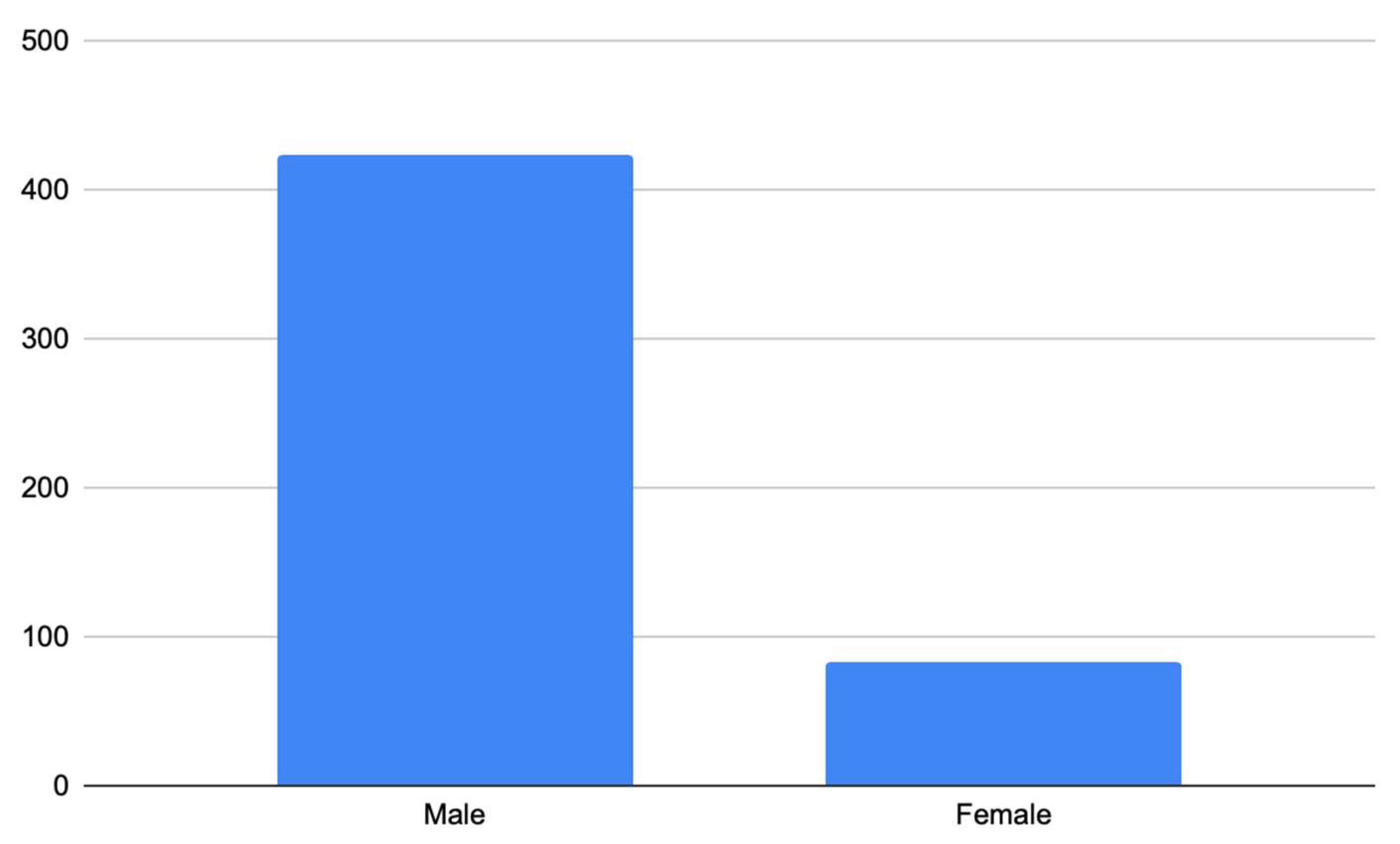
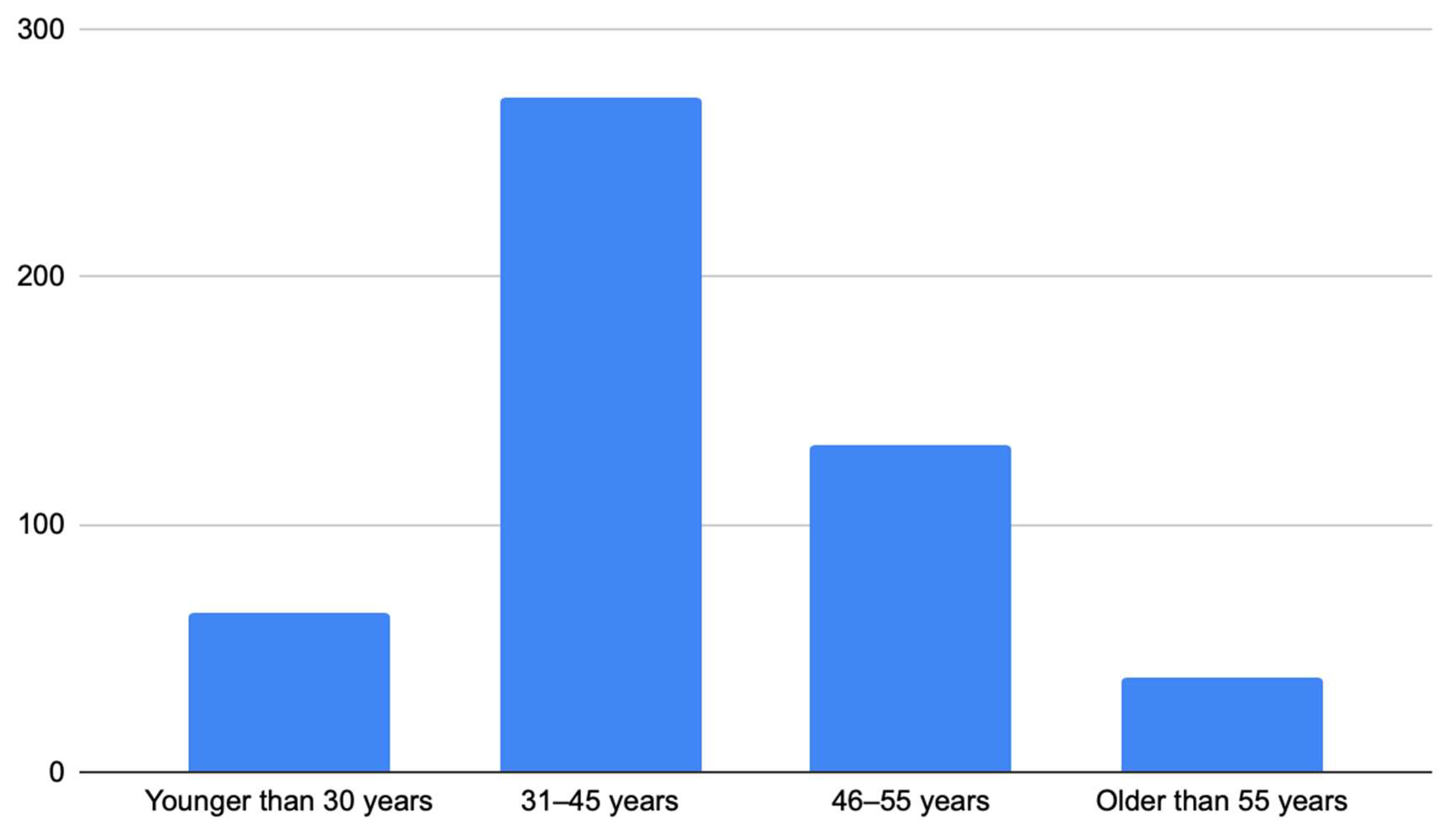
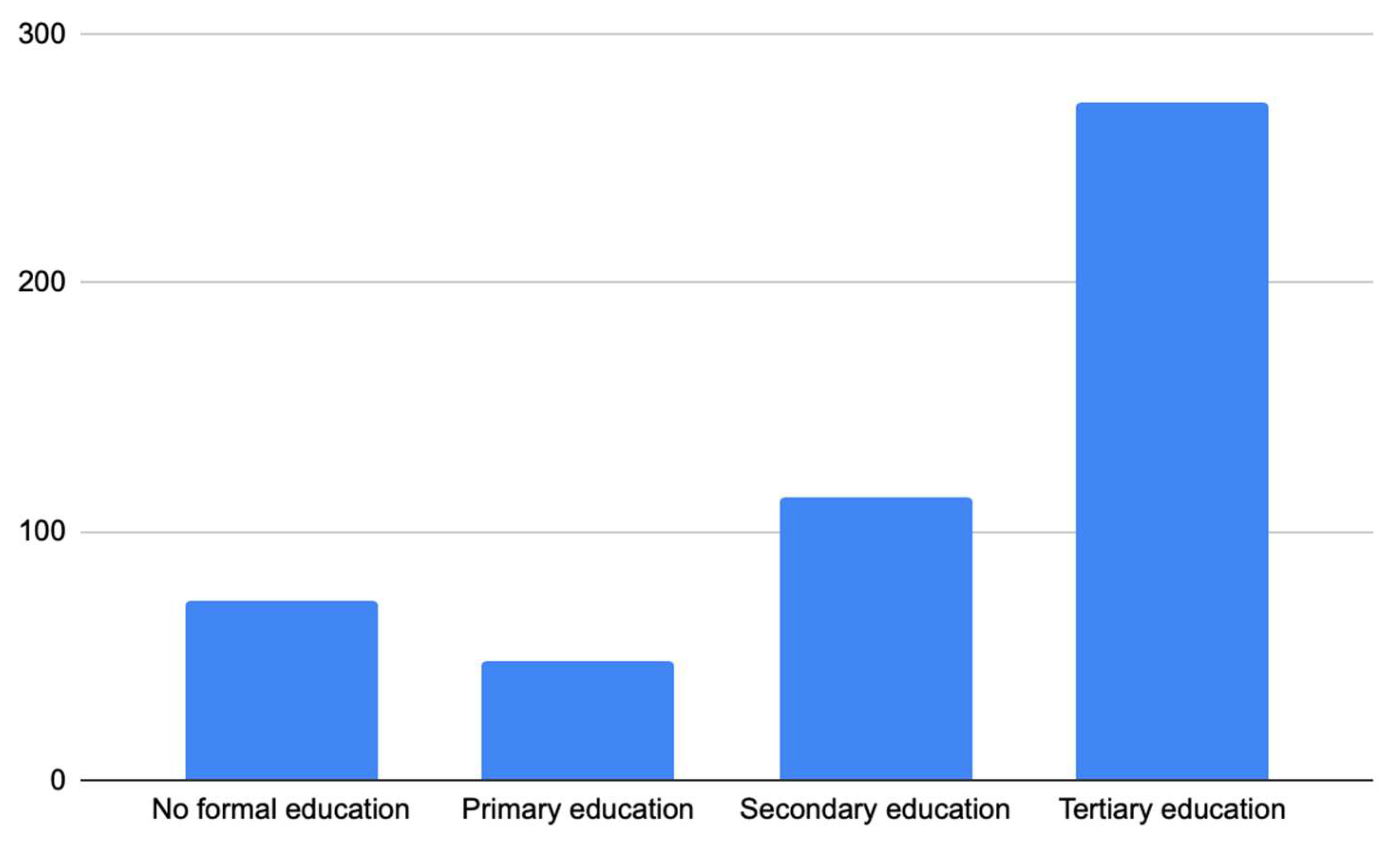
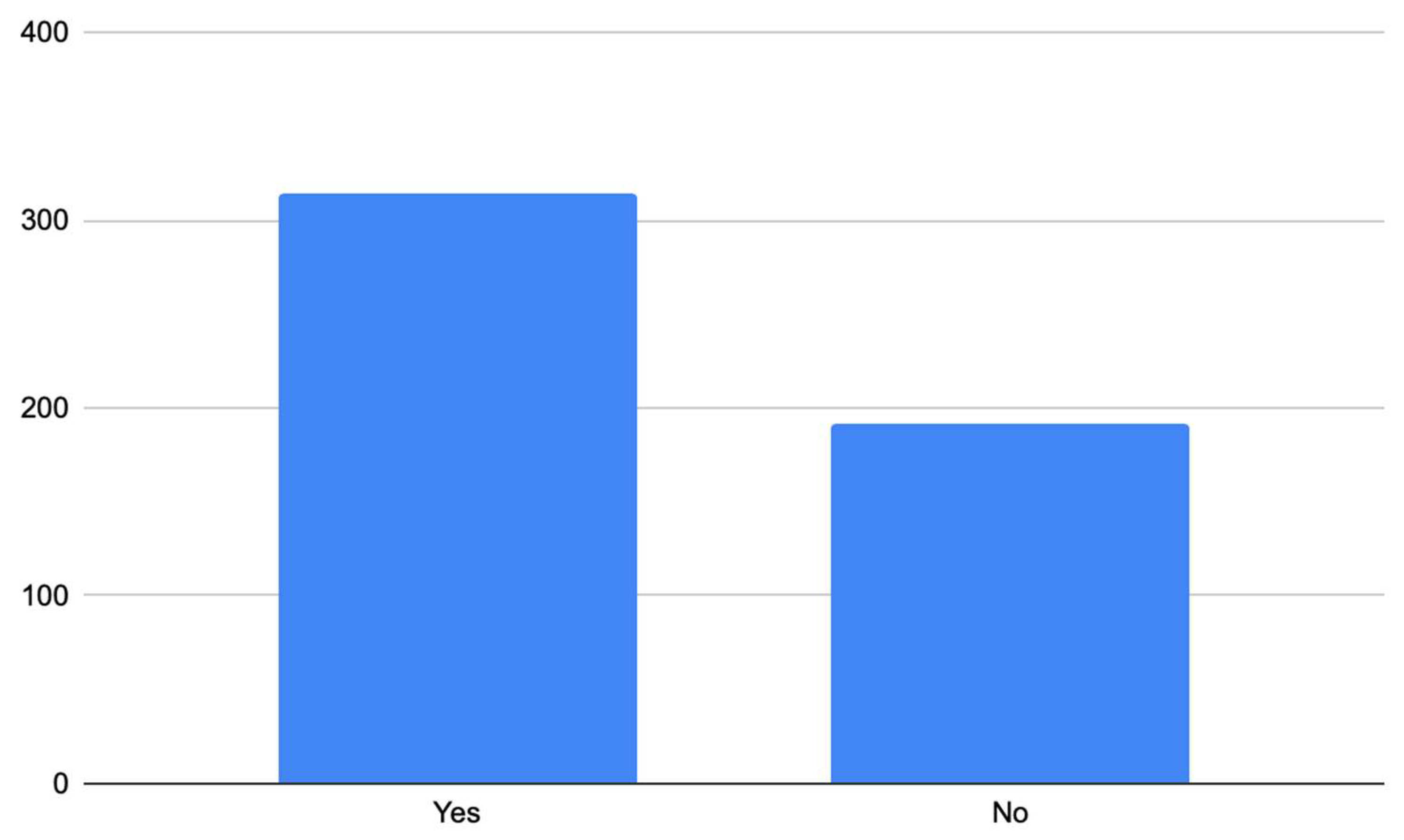
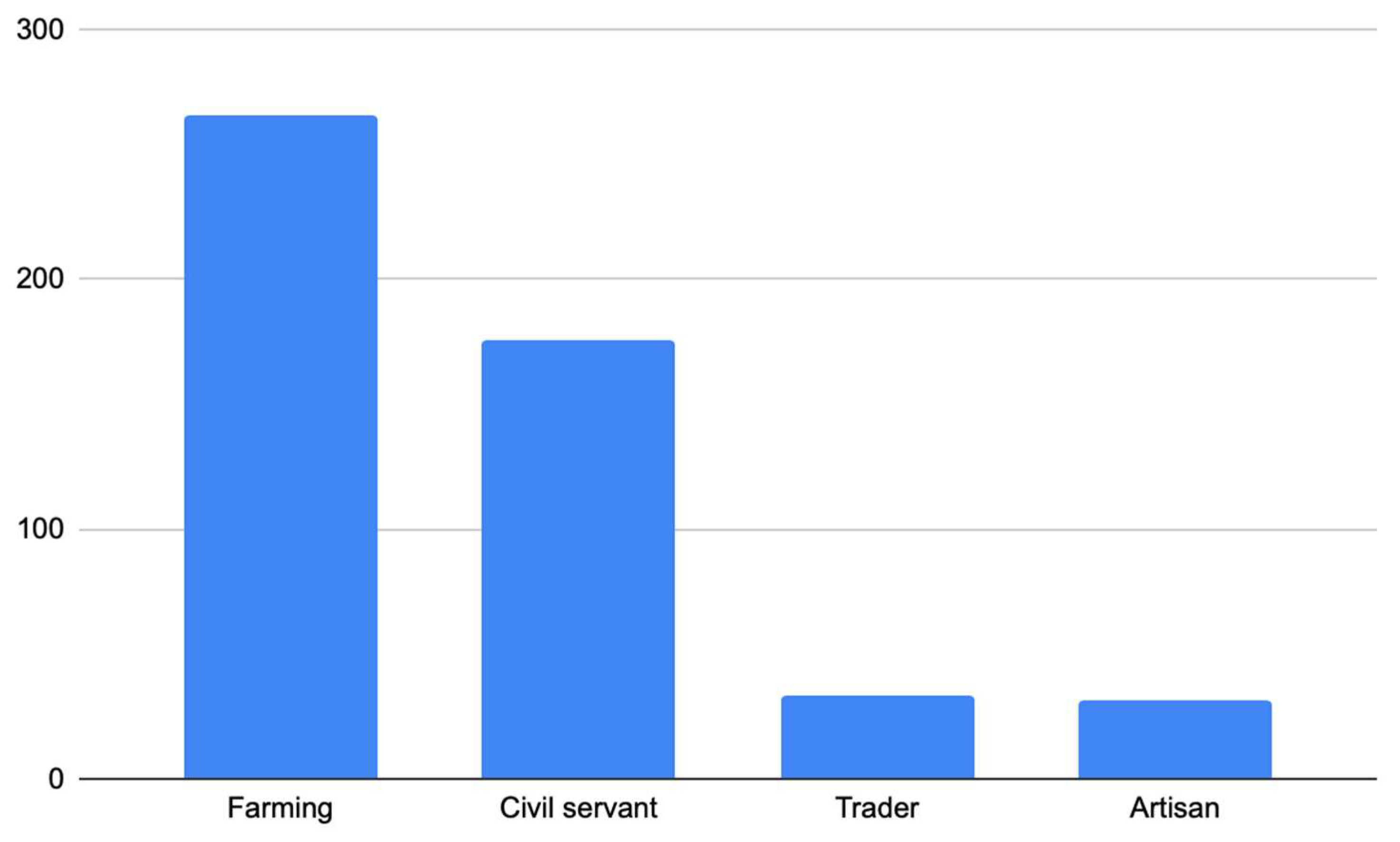
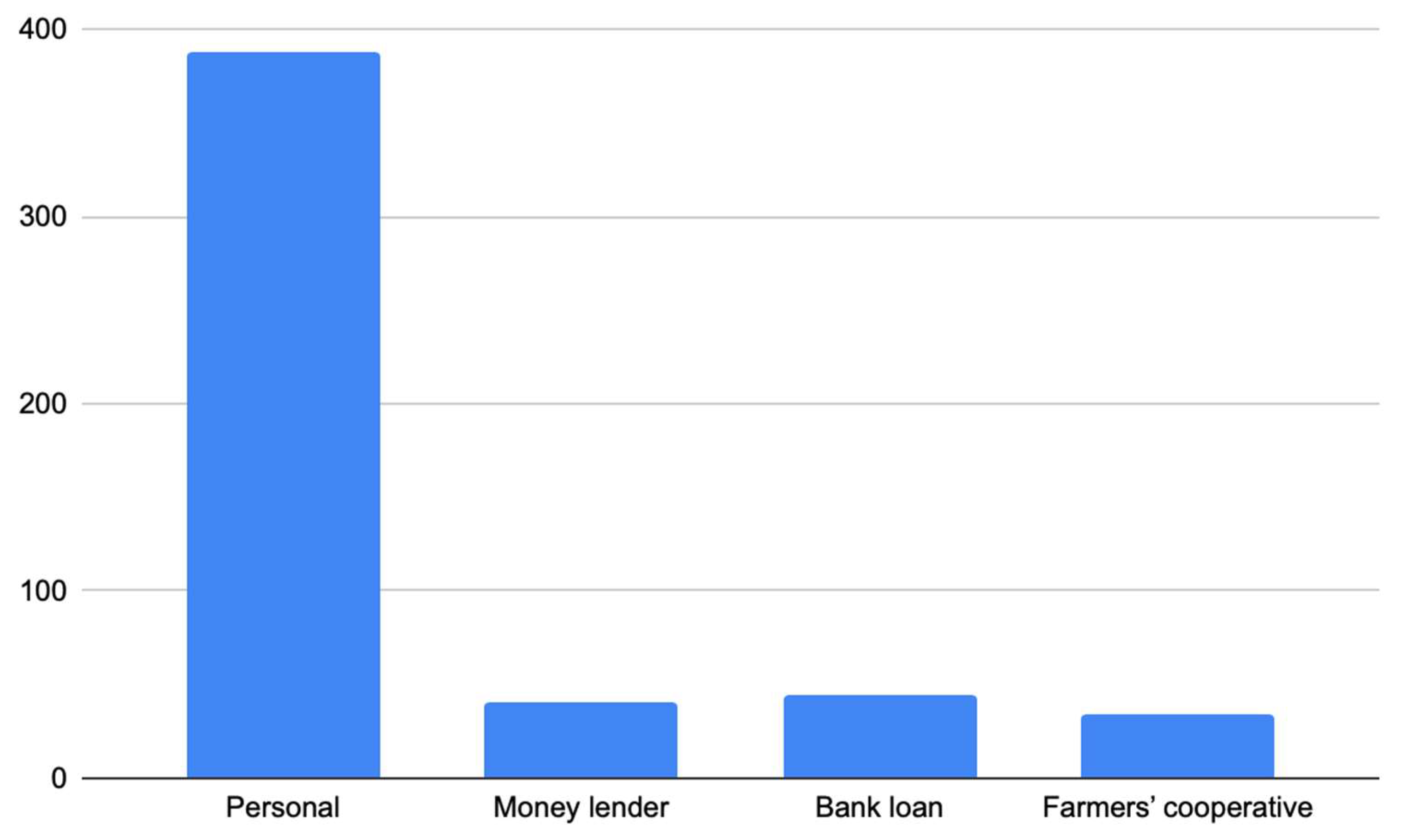
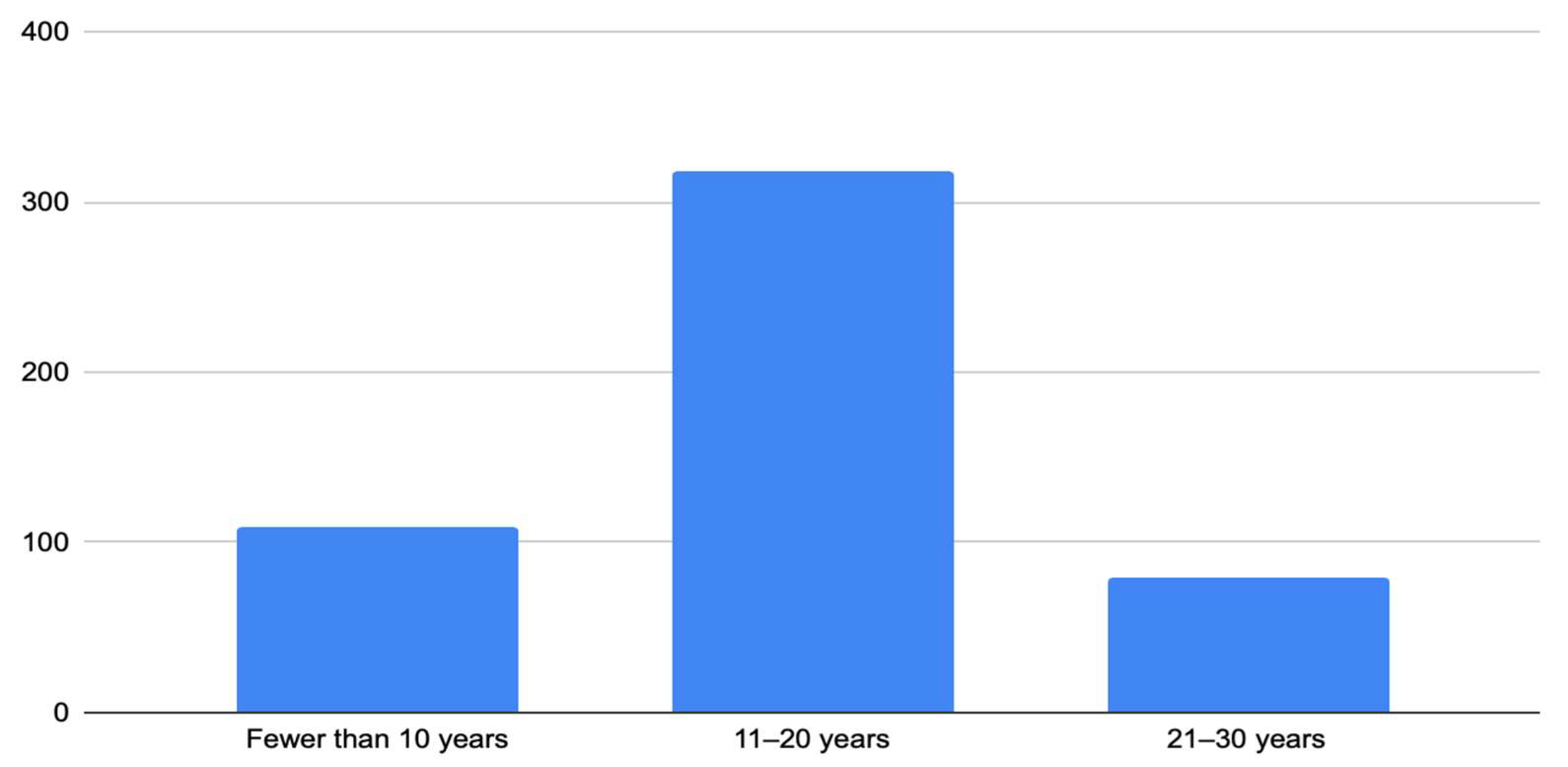

| Sample (n) | Percentage (%) | |
|---|---|---|
| Sex | ||
| Male | 423 | 83.60 |
| Female | 83 | 16.40 |
| Age | ||
| Younger than 30 years | 64 | 12.60 |
| 31–45 years | 272 | 53.80 |
| 46–55 years | 132 | 26.10 |
| Older than 55 years | 38 | 7.50 |
| Education status | ||
| No formal education | 72 | 14.20 |
| Primary education | 48 | 9.50 |
| Secondary education | 114 | 22.50 |
| Tertiary education | 272 | 53.80 |
| Farmers’ cooperative membership | ||
| Yes | 314 | 62.10 |
| No | 192 | 37.90 |
| Main occupation | ||
| Farming | 266 | 52.60 |
| Civil servant | 176 | 34.80 |
| Trader | 33 | 6.50 |
| Artisan | 31 | 6.10 |
| Major source of funding | ||
| Personal | 388 | 76.70 |
| Money lender | 40 | 7.90 |
| Bank loan | 44 | 8.70 |
| Farmers’ cooperative | 34 | 6.70 |
| Years of experience | ||
| Fewer than 10 years | 109 | 21.50 |
| 11–20 years | 318 | 62.80 |
| 21–30 years | 79 | 15.60 |
| Total | 506 | 100.00 |
| Sample (n) | Std. Dev. | Min | Max | ||
|---|---|---|---|---|---|
| Belief in climate change | 506 | 14.07 | 3.21 | 4 | 20 |
| Climate change awareness | 506 | 50.23 | 9.92 | 21 | 69 |
| Risk perception of climate change | 506 | 36.15 | 6.93 | 10 | 49 |
| Adaptation assessment towards climate change | 506 | 16.15 | 3.76 | 5 | 24 |
| Self-efficacy towards climate change | 506 | 21.61 | 4.05 | 9 | 30 |
| Maladaptation to climate change | 506 | 12.26 | 1.57 | 7 | 15 |
| Ecological policies on climate change perception | 506 | 15.89 | 3.24 | 4 | 20 |
| Kolmogorov–Smirnov | |||||
|---|---|---|---|---|---|
| Statistic | Degrees of Freedom (df) | Significance Level (p) | Skewness | Kurtosis | |
| Belief in climate change | 0.149 | 506 | 0.000 | −0.548 | 0.255 |
| Climate change awareness | 0.104 | 506 | 0.000 | −0.525 | −0.314 |
| Risk perception of climate change | 0.099 | 506 | 0.000 | −0.647 | 0.060 |
| Adaptation assessment towards climate change | 0.090 | 506 | 0.000 | −0.231 | −0.614 |
| Self-efficacy towards climate change | 0.128 | 506 | 0.000 | −0.626 | −0.049 |
| Maladaptation to climate change | 0.179 | 506 | 0.000 | −0.311 | 0.366 |
| Ecological policies on climate change perception | 0.158 | 506 | 0.000 | −0.585 | 0.025 |
| Sex | Sample (n) | Std. Dev. | t-Statistic | Significance Level (p) | ||
|---|---|---|---|---|---|---|
| Belief in climate change | Male | 423 | 14.30 | 3.12 | 3.621 | 0.000 * |
| Female | 83 | 12.92 | 3.45 | |||
| Climate change awareness | Male | 423 | 51.59 | 9.20 | 7.314 | 0.000 * |
| Female | 83 | 43.30 | 10.60 | |||
| Risk perception of climate change | Male | 423 | 36.69 | 6.80 | 4.049 | 0.000 * |
| Female | 83 | 33.37 | 6.98 | |||
| Adaptation assessment towards climate change | Male | 423 | 16.53 | 3.67 | 5.356 | 0.000 * |
| Female | 83 | 14.18 | 3.60 | |||
| Self-efficacy towards climate change | Male | 423 | 21.99 | 3.90 | 4.891 | 0.000 * |
| Female | 83 | 19.66 | 4.24 | |||
| Maladaptation to climate change | Male | 423 | 12.30 | 1.54 | 1.271 | 0.204 |
| Female | 83 | 12.06 | 1.73 | |||
| Ecological policies on climate change perception | Male | 423 | 15.89 | 3.20 | 0.055 | 0.956 |
| Female | 83 | 15.87 | 3.42 |
| Age | Sample (n) | Std. Dev. | Min | Max | F-Statistic | Significance Level (p) | Pairwise Diff. | ||
|---|---|---|---|---|---|---|---|---|---|
| Belief in climate change | Younger than 30 years | 64 | 13.09 | 3.21 | 4 | 20 | 4.433 | 0.004 * | 1–4 |
| 31–45 years | 272 | 14.01 | 3.15 | 4 | 20 | ||||
| 46–55 years | 132 | 14.28 | 3.19 | 4 | 20 | ||||
| Older than 55 years | 38 | 15.39 | 3.30 | 6 | 20 | ||||
| Climate change awareness | Younger than 30 years | 64 | 44.58 | 10.68 | 23 | 67 | 8.714 | 0.000 * | 1–2 |
| 31–45 years | 272 | 51.12 | 9.36 | 21 | 69 | 1–3 | |||
| 46–55 years | 132 | 50.50 | 9.72 | 24 | 65 | 1–4 | |||
| Older than 55 years | 38 | 52.47 | 10.31 | 27 | 65 | ||||
| Risk perception of climate change | Younger than 30 years | 64 | 34.63 | 6.90 | 20 | 49 | 3.803 | 0.010 * | 1–4 |
| 31–45 years | 272 | 35.99 | 6.73 | 15 | 49 | ||||
| 46–55 years | 132 | 36.30 | 7.18 | 10 | 49 | ||||
| Older than 55 years | 38 | 39.32 | 6.80 | 20 | 47 | ||||
| Adaptation assessment towards climate change | Younger than 30 years | 64 | 15.83 | 3.67 | 6 | 24 | 4.520 | 0.004 * | 1–4 |
| 31–45 years | 272 | 15.89 | 3.63 | 5 | 24 | 2–4 | |||
| 46–55 years | 132 | 16.23 | 4.07 | 7 | 24 | ||||
| Older than 55 years | 38 | 18.21 | 3.06 | 10 | 24 | ||||
| Self-efficacy towards climate change | Younger than 30 years | 64 | 20.73 | 4.35 | 9 | 29 | 2.978 | 0.031 * | 1–4 |
| 31–45 years | 272 | 21.48 | 3.79 | 10 | 29 | ||||
| 46–55 years | 132 | 21.87 | 4.10 | 9 | 30 | ||||
| Older than 55 years | 38 | 23.08 | 4.83 | 9 | 29 | ||||
| Maladaptation to climate change | Younger than 30 years | 64 | 12.39 | 1.90 | 7 | 15 | 2.146 | 0.094 | |
| 31–45 years | 272 | 12.14 | 1.46 | 7 | 15 | ||||
| 46–55 years | 132 | 12.30 | 1.55 | 7 | 15 | ||||
| Older than 55 years | 38 | 12.79 | 1.74 | 9 | 15 | ||||
| Ecological policies on climate change perception | Younger than 30 years | 64 | 14.75 | 3.71 | 4 | 20 | 3.222 | 0.022 * | 1–2 |
| 31–45 years | 272 | 16.14 | 3.19 | 8 | 20 | ||||
| 46–55 years | 132 | 15.89 | 2.89 | 7 | 20 | ||||
| Older than 55 years | 38 | 15.97 | 3.54 | 6 | 20 |
| Education Status | Sample (n) | Std. Dev. | Min | Max | F-Statistic | Significance Level (p) | Pairwise Diff. | ||
|---|---|---|---|---|---|---|---|---|---|
| Belief in climate change | No formal education | 72 | 13.36 | 3.84 | 4 | 20 | 2.164 | 0.091 | |
| Primary education | 48 | 13.83 | 2.82 | 8 | 20 | ||||
| Secondary education | 114 | 14.56 | 3.54 | 4 | 20 | ||||
| Tertiary education | 272 | 14.09 | 2.92 | 4 | 20 | ||||
| Climate change awareness | No formal education | 72 | 42.54 | 9.94 | 21 | 66 | 19.389 | 0.000 * | 1–2 |
| Primary education | 48 | 49.81 | 9.62 | 32 | 68 | 1–3 | |||
| Secondary education | 114 | 51.21 | 9.49 | 24 | 66 | 1–4 | |||
| Tertiary education | 272 | 51.93 | 9.22 | 25 | 69 | ||||
| Risk perception of climate change | No formal education | 72 | 33.31 | 7.69 | 15 | 49 | 5.106 | 0.002 * | 1–2 |
| Primary education | 48 | 35.83 | 8.43 | 20 | 49 | 1–3 | |||
| Secondary education | 114 | 36.92 | 7.05 | 10 | 47 | 1–4 | |||
| Tertiary education | 272 | 36.63 | 6.19 | 18 | 49 | ||||
| Adaptation assessment towards climate change | No formal education | 72 | 14.65 | 3.34 | 8 | 24 | 12.690 | 0.000 * | 1–3 |
| Primary education | 48 | 14.00 | 3.48 | 6 | 20 | 1–4 | |||
| Secondary education | 114 | 16.88 | 4.00 | 7 | 24 | 2–3 | |||
| Tertiary education | 272 | 16.61 | 3.57 | 5 | 24 | 2–4 | |||
| Self-efficacy towards climate change | No formal education | 72 | 20.35 | 3.88 | 10 | 27 | 5.815 | 0.001 * | 1–3 |
| Primary education | 48 | 20.40 | 3.75 | 9 | 27 | 1–4 | |||
| Secondary education | 114 | 22.46 | 4.34 | 9 | 30 | 2–3 | |||
| Tertiary education | 272 | 21.79 | 3.91 | 9 | 29 | 2–4 | |||
| Maladaptation to climate change | No formal education | 72 | 12.38 | 1.73 | 7 | 15 | 0.848 | 0.468 | |
| Primary education | 48 | 11.96 | 1.17 | 8 | 15 | ||||
| Secondary education | 114 | 12.35 | 1.85 | 7 | 15 | ||||
| Tertiary education | 272 | 12.25 | 1.47 | 7 | 15 | ||||
| Ecological policies on climate change perception | No formal education | 72 | 15.11 | 3.12 | 7 | 20 | 3.649 | 0.013 * | 1–4 |
| Primary education | 48 | 15.63 | 2.60 | 8 | 20 | 2–4 | |||
| Secondary education | 114 | 15.48 | 2.87 | 8 | 20 | 3–4 | |||
| Tertiary education | 272 | 16.31 | 3.45 | 4 | 20 |
| Farmers’ Cooperative Membership | Sample (n) | Std. Dev. | t-Statistic | Significance Level (p) | ||
|---|---|---|---|---|---|---|
| Belief in climate change | Yes | 314 | 1397 | 3.21 | −0.847 | 0.397 |
| No | 192 | 14.22 | 3.22 | |||
| Climate change awareness | Yes | 314 | 51.20 | 10.17 | 2.833 | 0.005 * |
| No | 192 | 48.65 | 9.31 | |||
| Risk perception of climate change | Yes | 314 | 36.46 | 6.75 | 1.289 | 0.198 |
| No | 192 | 35.64 | 7.21 | |||
| Adaptation assessment towards climate change | Yes | 314 | 16.30 | 3.70 | 1.149 | 0.251 |
| No | 192 | 15.90 | 3.85 | |||
| Self-efficacy towards climate change | Yes | 314 | 21.87 | 3.82 | 1.894 | 0.059 |
| No | 192 | 21.17 | 4.37 | |||
| Maladaptation to climate change | Yes | 314 | 12.31 | 1.54 | 0.878 | 0.380 |
| No | 192 | 12.18 | 1.63 | |||
| Ecological policies on climate change perception | Yes | 314 | 16.32 | 3.24 | 3.963 | 0.000 * |
| No | 192 | 15.17 | 3.10 |
| Main Occupation | Sample (n) | Std. Dev. | Min | Max | F-Statistic | Significance Level (p) | Pairwise Diff. | ||
|---|---|---|---|---|---|---|---|---|---|
| Belief in climate change | Farming | 266 | 14.03 | 3.25 | 4 | 20 | 1.725 | 0.161 | |
| Civil servant | 176 | 14.31 | 2.72 | 8 | 20 | ||||
| Trader | 33 | 12.94 | 4.21 | 4 | 20 | ||||
| Artisan | 31 | 14.23 | 4.03 | 4 | 19 | ||||
| Climate change awareness | Farming | 266 | 49.82 | 10.36 | 21 | 68 | 8.982 | 0.000 * | 1–3 |
| Civil servant | 176 | 52.40 | 8.46 | 25 | 69 | 2–3 | |||
| Trader | 33 | 43.24 | 8.98 | 23 | 62 | 3–4 | |||
| Artisan | 31 | 48.97 | 11.07 | 25 | 64 | ||||
| Risk perception of climate change | Farming | 266 | 36.09 | 7.41 | 10 | 49 | 1.490 | 0.216 | |
| Civil servant | 176 | 36.64 | 6.01 | 18 | 46 | ||||
| Trader | 33 | 33.88 | 6.64 | 21 | 46 | ||||
| Artisan | 31 | 36.26 | 7.67 | 20 | 47 | ||||
| Adaptation assessment towards climate change | Farming | 266 | 15.70 | 3.85 | 6 | 24 | 4.973 | 0.002 * | 2–3 |
| Civil servant | 176 | 16.90 | 3.63 | 5 | 24 | 3–4 | |||
| Trader | 33 | 15.06 | 3.47 | 8 | 24 | ||||
| Artisan | 31 | 16.81 | 3.19 | 12 | 22 | ||||
| Self-efficacy towards climate change | Farming | 266 | 21.33 | 3.91 | 9 | 30 | 2.488 | 0.060 | |
| Civil servant | 176 | 22.19 | 3.94 | 12 | 29 | ||||
| Trader | 33 | 20.52 | 4.56 | 9 | 28 | ||||
| Artisan | 31 | 21.81 | 4.94 | 11 | 29 | ||||
| Maladaptation to climate change | Farming | 266 | 12.14 | 1.56 | 7 | 15 | 2.952 | 0.032 * | 3–4 |
| Civil servant | 176 | 12.37 | 1.44 | 7 | 15 | ||||
| Trader | 33 | 12.06 | 1.98 | 8 | 15 | ||||
| Artisan | 31 | 12.94 | 1.82 | 9 | 15 | ||||
| Ecological policies on climate change perception | Farming | 266 | 15.93 | 3.08 | 4 | 20 | 2.951 | 0.032 * | 2–4 |
| Civil servant | 176 | 16.19 | 3.42 | 4 | 20 | ||||
| Trader | 33 | 15.18 | 3.00 | 11 | 20 | ||||
| Artisan | 31 | 14.52 | 3.41 | 8 | 20 |
| Major Source of Funding | Sample (n) | Std. Dev. | Min | Max | F-Statistic | Significance Level (p) | Pairwise Diff. | ||
|---|---|---|---|---|---|---|---|---|---|
| Belief in climate change | Personal | 388 | 14.32 | 3.17 | 4 | 20 | 7.464 | 0.000 * | 1–4 |
| Money lender | 40 | 13.13 | 2.62 | 8 | 20 | 2–4 | |||
| Bank loan | 44 | 14.34 | 3.21 | 7 | 20 | 3–4 | |||
| Farmers’ cooperative | 34 | 11.91 | 3.41 | 4 | 19 | ||||
| Climate change awareness | Personal | 388 | 51.04 | 10.13 | 21 | 69 | 4.967 | 0.002 * | 1–4 |
| Money lender | 40 | 47.30 | 6.49 | 30 | 62 | 2–4 | |||
| Bank loan | 44 | 49.59 | 9.69 | 27 | 66 | 3–4 | |||
| Farmers’ cooperative | 34 | 45.32 | 9.39 | 24 | 62 | ||||
| Risk perception of climate change | Personal | 388 | 37.05 | 6.72 | 15 | 49 | 13.969 | 0.000 * | 1–4 |
| Money lender | 40 | 32.35 | 5.26 | 22 | 47 | 3–4 | |||
| Bank loan | 44 | 35.82 | 7.46 | 10 | 43 | ||||
| Farmers’ cooperative | 34 | 30.79 | 6.62 | 20 | 42 | ||||
| Adaptation assessment towards climate change | Personal | 388 | 16.29 | 3.84 | 5 | 24 | 5.194 | 0.002 * | 1–4 |
| Money lender | 40 | 15.68 | 3.48 | 10 | 24 | 3–4 | |||
| Bank loan | 44 | 17.00 | 3.25 | 8 | 23 | ||||
| Farmers’ cooperative | 34 | 13.94 | 2.83 | 7 | 20 | ||||
| Self-efficacy towards climate change | Personal | 388 | 21.97 | 3.86 | 9 | 29 | 9.122 | 0.000 * | 1–4 |
| Money lender | 40 | 19.80 | 3.98 | 12 | 29 | 3–4 | |||
| Bank loan | 44 | 22.09 | 4.07 | 12 | 28 | ||||
| Farmers’ cooperative | 34 | 18.97 | 4.79 | 9 | 30 | ||||
| Maladaptation to climate change | Personal | 388 | 12.38 | 1.50 | 7 | 15 | 6.714 | 0.000 * | 1–2 |
| Money lender | 40 | 11.25 | 1.50 | 8 | 15 | 2–3 | |||
| Bank loan | 44 | 12.07 | 1.81 | 8 | 15 | 2–4 | |||
| Farmers’ cooperative | 34 | 12.32 | 1.79 | 7 | 15 | ||||
| Ecological policies on climate change perception | Personal | 388 | 16.05 | 3.14 | 4 | 20 | 4.558 | 0.004 * | 1–2 |
| Money lender | 40 | 14.20 | 3.55 | 8 | 20 | 2–3 | |||
| Bank loan | 44 | 16.32 | 3.39 | 8 | 20 | 2–4 | |||
| Farmers’ cooperative | 34 | 15.41 | 3.19 | 10 | 20 |
| Years of Experience | Sample (n) | Std. Dev. | Min | Max | F-Statistic | Significance Level (p) | Pairwise Diff. | ||
|---|---|---|---|---|---|---|---|---|---|
| Belief in climate change | Fewer than 10 years | 109 | 14.04 | 3.82 | 4 | 20 | 0.033 | 0.968 | |
| 11–20 years | 318 | 14.06 | 3.05 | 4 | 20 | ||||
| 21–30 years | 79 | 14.15 | 2.96 | 6 | 19 | ||||
| Climate change awareness | Fewer than 10 years | 109 | 47.32 | 11.51 | 21 | 68 | 6.674 | 0.001 * | 1–2 |
| 11–20 years | 318 | 50.77 | 9.49 | 23 | 69 | 1–3 | |||
| 21–30 years | 79 | 52.08 | 8.44 | 29 | 68 | ||||
| Risk perception of climate change | Fewer than 10 years | 109 | 35.55 | 7.67 | 20 | 49 | 1.057 | 0.348 | |
| 11–20 years | 318 | 36.13 | 6.83 | 10 | 49 | ||||
| 21–30 years | 79 | 37.04 | 6.22 | 20 | 47 | ||||
| Adaptation assessment towards climate change | Fewer than 10 years | 109 | 16.32 | 3.93 | 6 | 24 | 0.336 | 0.715 | |
| 11–20 years | 318 | 16.04 | 3.70 | 5 | 24 | ||||
| 21–30 years | 79 | 16.33 | 3.77 | 7 | 24 | ||||
| Self-efficacy towards climate change | Fewer than 10 years | 109 | 21.23 | 4.54 | 9 | 29 | 1.622 | 0.199 | |
| 11–20 years | 318 | 21.57 | 3.75 | 10 | 29 | ||||
| 21–30 years | 79 | 22.29 | 4.45 | 9 | 30 | ||||
| Maladaptation to climate change | Fewer than 10 years | 109 | 12.61 | 1.84 | 7 | 15 | 4.291 | 0.014 * | 1–2 |
| 11–20 years | 318 | 12.11 | 1.41 | 7 | 15 | 1–3 | |||
| 21–30 years | 79 | 12.38 | 1.74 | 8 | 15 | ||||
| Ecological policies on climate change perception | Fewer than 10 years | 109 | 14.88 | 3.57 | 4 | 20 | 7.986 | 0.000 * | 1–2 |
| 11–20 years | 318 | 16.28 | 2.93 | 7 | 20 | 1–3 | |||
| 21–30 years | 79 | 15.68 | 3.61 | 6 | 20 |
| Belief in Climate Change | Climate Change Awareness | Risk Perception of Climate Change | Adaptation Assessment Towards Climate Change | Self-Efficacy Towards Climate Change | Maladaptation to Climate Change | Ecological Policies on Climate Change Perception | ||
|---|---|---|---|---|---|---|---|---|
| Belief in climate change | r | 1 | ||||||
| p | ||||||||
| N | 506 | |||||||
| Climate change awareness | r | 0.477 ** | 1 | |||||
| p | 0.000 | |||||||
| N | 506 | 506 | ||||||
| Risk perception of climate change | r | 0.332 ** | 0.601 ** | 1 | ||||
| p | 0.000 | 0.000 | ||||||
| N | 506 | 506 | 506 | |||||
| Adaptation assessment towards climate change | r | 0.315 ** | 0.441 ** | 0.487 ** | 1 | |||
| p | 0.000 | 0.000 | 0.000 | |||||
| N | 506 | 506 | 506 | 506 | ||||
| Self-efficacy towards climate change | r | 0.327 ** | 0.440 ** | 0.419 ** | 0.480 ** | 1 | ||
| p | 0.000 | 0.000 | 0.000 | 0.000 | ||||
| N | 506 | 506 | 506 | 506 | 506 | |||
| Maladaptation to climate change | r | 0.165 ** | 0.134 ** | 0.134 ** | 0.217 ** | 0.325 ** | 1 | |
| p | 0.000 | 0.002 | 0.003 | 0.000 | 0.000 | |||
| N | 506 | 506 | 506 | 506 | 506 | 506 | ||
| Ecological policies on climate change perception | r | 0.123 ** | 0.215 ** | 0.173 ** | 0.177 ** | 0.271 ** | 0.278 ** | 1 |
| p | 0.006 | 0.000 | 0.000 | 0.000 | 0.000 | 0.000 | ||
| N | 506 | 506 | 506 | 506 | 506 | 506 | 506 |
Disclaimer/Publisher’s Note: The statements, opinions and data contained in all publications are solely those of the individual author(s) and contributor(s) and not of MDPI and/or the editor(s). MDPI and/or the editor(s) disclaim responsibility for any injury to people or property resulting from any ideas, methods, instructions or products referred to in the content. |
© 2025 by the authors. Licensee MDPI, Basel, Switzerland. This article is an open access article distributed under the terms and conditions of the Creative Commons Attribution (CC BY) license (https://creativecommons.org/licenses/by/4.0/).
Share and Cite
Agila, F.A.R.; Kiraz, A. Climate Change and Agricultural Risks: Perception of Farmers from a Socio-Economic Sustainability Perspective. Sustainability 2025, 17, 7285. https://doi.org/10.3390/su17167285
Agila FAR, Kiraz A. Climate Change and Agricultural Risks: Perception of Farmers from a Socio-Economic Sustainability Perspective. Sustainability. 2025; 17(16):7285. https://doi.org/10.3390/su17167285
Chicago/Turabian StyleAgila, Fadel Ali Ramadan, and Askin Kiraz. 2025. "Climate Change and Agricultural Risks: Perception of Farmers from a Socio-Economic Sustainability Perspective" Sustainability 17, no. 16: 7285. https://doi.org/10.3390/su17167285
APA StyleAgila, F. A. R., & Kiraz, A. (2025). Climate Change and Agricultural Risks: Perception of Farmers from a Socio-Economic Sustainability Perspective. Sustainability, 17(16), 7285. https://doi.org/10.3390/su17167285








